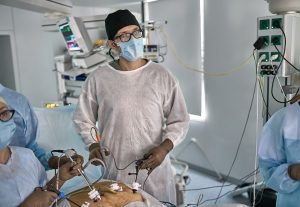With the advancements in surgical procedures, more operating rooms are performing ‘minimally invasive’ surgeries. What that means is, instead of operating on patients through large incisions, miniaturized surgical instruments are being used to fit through small, sometimes as small as quarter-inch, incisions. The surgical precision lenses in these instruments contain magnified high-definition 3-D cameras that guide the surgeon during the procedures.
 The instruments and the camera are all controlled by the surgeon from a console located in the operating room. Using the master controls, the surgeon has the ability to operate the surgical instrument simultaneously while looking through a stereoscopic high-definition monitor that seems to literally place him inside the patient. This allows for a better, more detailed view of the operating site than the human eye can provide, as it is in 3-D. Every movement made with the master controls is replicated precisely by the surgical ‘robot’. The surgeon’s hand, wrist and finger movements are transmitted through the computer console to the instruments attached to the robotic arms. The mimicked movements have the same range of motion as the surgeon allowing for maximum control. So highly tuned, the equipment even steadies any random movements, allowing for the highest level of precision.
The instruments and the camera are all controlled by the surgeon from a console located in the operating room. Using the master controls, the surgeon has the ability to operate the surgical instrument simultaneously while looking through a stereoscopic high-definition monitor that seems to literally place him inside the patient. This allows for a better, more detailed view of the operating site than the human eye can provide, as it is in 3-D. Every movement made with the master controls is replicated precisely by the surgical ‘robot’. The surgeon’s hand, wrist and finger movements are transmitted through the computer console to the instruments attached to the robotic arms. The mimicked movements have the same range of motion as the surgeon allowing for maximum control. So highly tuned, the equipment even steadies any random movements, allowing for the highest level of precision.
For the surgeon, the benefits of using surgical robots include:
- Greater visualization
- Enhanced dexterity
- Greater precision
- Reduced fatigue
Though the real benefit is probably seen by the patient. When compared to open surgery, with minimally invasive surgery the patient experiences:
- Shorter hospitalization
- Reduced pain and discomfort
- Faster recovery time with a quicker return to normal activities
- Smaller incisions leading to reduced risk of infection
- Reduced blood loss and need for transfusions
- Minimal scarring
In 2016, there were about 4,000 surgical robots scattered throughout the world, and they assisted in approximately 750,000 operations. Most of those procedures where on prostate glands and within the uterus. However, they were also assisted surgeons with surgical procedures to the kidneys, heart, colon, along with hips and knees.
That number is likely to grow exponentially in the near future. With the continual miniaturization of electronics, smarter circuit boards can be fitted into smaller and more versatile robotic arms. This will expand the range of procedures that are a viable option for minimally invasive surgery.
Universe Optics specializes in the manufacturing and design of precision lenses capable of delivering the clarity required under such conditions as the operating room demands. Our team of experts works with your specific requirements for your exact design for your surgical precision lenses.
Currently, robotic surgery is approved for over 50 procedures in:
- Bariatrics
- Cardiothoracic surgery
- Colorectal surgery
- Otolaryngology – Head & Neck
- General surgery
- Gynecology
- Gynecologic Oncology
- Reproductive Endocrinology & Infertility
- Urology
It’s impossible to tell where technology will take the medical field. However, through the use of the internet, high-precision 3-D cameras, and stereoscopic monitors, some doctors are anticipating the growth of tele-medicine and possibly long-distance operations. Practically, this would mean that surgical centers would be set up in different parts of the world and a doctor could go to a surgical center and sit in a control console while a patient in a different surgical center would be operated on by a robot controlled by that doctor.